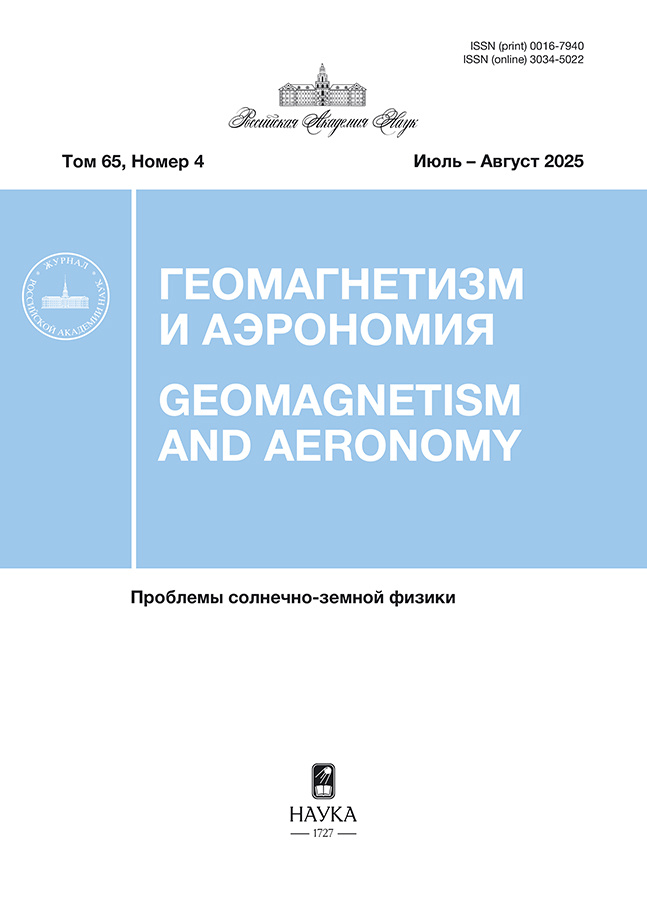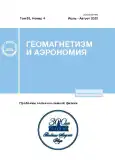Diurnal Variations of the Statistical Characteristics of NmF2 Variability According to Ground-Based Low Latitude Ionosondes in Geomagnetically Quiet Conditions at Low Solar Activity
- Authors: Pavlov A.V.1, Pavlova N.M.1
-
Affiliations:
- Pushkov Institute of Terrestrial Magnetism, the Ionosphere, and Radio Wave Propagation, Russian Academy of Sciences
- Issue: Vol 63, No 4 (2023)
- Pages: 429-440
- Section: Articles
- URL: https://gynecology.orscience.ru/0016-7940/article/view/650996
- DOI: https://doi.org/10.31857/S0016794022600685
- EDN: https://elibrary.ru/OUPJBS
- ID: 650996
Cite item
Abstract
The study of diurnal variations of the statistical characteristics of the day-to-day variability of the
NmF2 electron number density of the F2 ionosphere layer for each month (M) of the year in geomagnetically
quiet conditions at low solar activity according to hourly measurements of the critical frequency of the F2 ionosphere
layer was carried out in Huancayo and Jicamarca. We calculated the NmF2E mathematical expectation,
the NmF2A arithmetic mean, the most probable NmF2MP, the NmF2MED arithmetic mean monthly
median, standard deviations σE, σA, σMP, and σMED and coefficients of variations CVE, CVA, CVMP, and
CVMED of the NmF2 value from NmF2E, NmF2A, NmF2MP, and NmF2MED, respectively. It has been found
that the difference of NmF2MED(UT,M) from NmF2E(UT,M) does not exceed 46%, NmF2MP(UT,M) from
NmF2E(UT,M): 102% and NmF2MP(UT,M) from NmF2MED(UT,M): 85%, where UT is Universal Time.
The calculated statistical parameters σE, σA, σMP, σMED, CVE, CVA, CVMP, and CVMED are the characteristics
of the NmF2 variability from one day to another day at fixed M and UT values over low-latitude Huancayo
and Jicamarca ionosondes in geomagnetically quiet conditions at low solar activity. The calculations showed
that the CVE, CVMED, and CVMP coefficients vary between 18%–82%, 19%–107%, and 18%–288%, respectively,
and in the majority of cases, CVE(UT,M) is less than CVMED (UT,M) and CVMP(UT,M). It was shown
that minimizing the standard deviation and the variation coefficient of NmF2 using the mathematical expectation
of NmF2 provides the best description of the set of NmF2 measurements with one single NmF2 statistical
parameter under the considered conditions. The lowest CVE varies from 18% (April) to 29% (September)
and the highest CVE ranges from 63% (November) to 73% (January). The average CVE value (average relative
day-to-day variability of NmF2) is highest in September (40%) and lowest in April (33%).
About the authors
A. V. Pavlov
Pushkov Institute of Terrestrial Magnetism, the Ionosphere, and Radio Wave Propagation, Russian Academy of Sciences
Email: pavlov@izmiran.ru
Moscow, Troitsk, 142190 Russia
N. M. Pavlova
Pushkov Institute of Terrestrial Magnetism, the Ionosphere, and Radio Wave Propagation, Russian Academy of Sciences
Author for correspondence.
Email: pavlov@izmiran.ru
Moscow, Troitsk, 142190 Russia
References
- – Агекян Т.А. Основа теории ошибок для астрономов и физиков. М.: Наука, 148 с. 1968.
- – Акасофу С.-И. Полярные и магнитосферные суббури. М.: Мир, 316 с. 1971.
- – Кобзарь А.И. Прикладная математическая статистика. Для инженеров и научных работников. М.: Физматлит, 816 с. 2006.
- – Кремер Н.Ш. Теория вероятностей и математическая статистика. М.: ЮНИТИ-ДАНА, 551 с. 2012.
- – Павлов А.В., Павлова Н.М. Вариации статистических параметров зимней аномалии NmF2 с широтой и солнечной активностью // Геомагнетизм и аэрономия. Т. 52. № 3. С. 356–364. 2012.
- – Павлов А.В., Павлова Н.М. Зависимости от месяца года статистических характеристик NmF2 средних широт в геомагнито-спокойных условиях вблизи полдня при низкой солнечной активности // Геомагнетизм и аэрономия. Т. 55. № 4. С. 504–510. 2015. https://doi.org/10.7868/S0016794015040112
- – Павлов А.В., Павлова Н.М. Влияние вариаций солнечной активности на изменчивость NmF2 в геомагнито-спокойных условиях по данным ионозонда Москва // Геомагнетизм и аэрономия. Т. 62. № 3. С. 355–364. 2022. https://doi.org/10.31857/S0016794022030142
- – Пиггот В.П., Равер К. Руководство URSI по интерпретации и обработке ионограмм. М.: Наука, 342 с. 1978.
- – Bilitza D., Altadill D., Zhang Y., Mertens C., Truhlík V., Richards P., Reinisch B. The International Reference Ionosphere 2012 – A model of international collaboration // J. Space Weather Spac. V. 4. A07. 2014. https://doi.org/10.1051/swsc/2014004
- – Fang T.-W., Fuller-Rowell T., Yudin V., Matsuo T., Viereck R. Quantifying the sources of ionosphere day-to-day variability // J. Geophys. Res. – Space. V. 123. № 11. P. 9682–9696. 2018. https://doi.org/10.1029/2018JA025525
- – Forbes J.M., Palo S.E., Zhang X. Variability of the ionosphere // J. Atmos. Sol.-Terr. Phy. V. 62. № 8. P. 685–693. 2000. https://doi.org/10.1016/S1364-6826(00)00029-8
- – Gatti P.L. Probability Theory and Mathematical Statistics for Engineers. London and N.Y.: Spon Press of Taylor & Francis Group, 356 p. 2005.
- – Howell D.C. Statistical Methods for Psychology, Belmont, CA: Wadsworth Cengage Learning, 771 p. 2013.
- – Heelis R.A. Low- and Middle-Latitude Ionospheric Dynamics Associated With Magnetic Storms / Midlatitude Ionospheric Dynamics and Disturbances / Geophysical Monograph Series, 181 / Eds. P.M. Kintner Jr., A.J. Coster, T. Fuller-Rowell, A.J. Mannucci, M. Mendillo, R. Heelis. Washington, DC: American Geophysical Union. P. 51–62. 2008. https://doi.org/10.1029/181GM06
- – Levitin A.E., Gromova L.I., Gromov S.V., Dremukhina L.A. Kp-index and local high-latitudinal geomagnetic activity / Proc. the 9th International Conference “Problems of Geocosmos” / Eds. V.N. Troyan, M. Hayakawa, and V.S. Semenov. Saint-Petersburg: Saint-Petersburg State University. P. 295–300. 2012.
- – Liu H.-L., Richmond A.D. Attribution of ionospheric vertical plasma drift perturbations to large-scale waves and the dependence on solar activity // J. Geophys. Res. – Space. V. 118. № 9. P. 2452–2465. 2013. https://doi.org/10.1002/jgra.50265
- – Liu H., Stolle C., Förster M., Watanabe S. Solar activity dependence of the electron density in the equatorial anomaly regions observed by CHAMP // J. Geophys. Res. – Space. V. 112. № 11. A11311. 2007. https://doi.org/10.1029/2007JA012616
- – Pavlov A.V. The low and middle latitude semi-annual anomaly in NmF2 near noon: a statisticalstudy // Adv. Space Res. V. 49. № 5. P. 922−936. 2012. https://doi.org/10.1016/j.asr.2011.12.024
- – Pavlov A.V. Causes of the mid-latitudinal daytime NmF2 semi-annual anomaly at solar minimum // J. Atmos. Sol.-Terr. Phy. V. 169. № 4. P. 6−15. 2018. https://doi.org/10.1016/j.jastp.2017.12.015
- – Pavlov A.V., Pavlova N.M., Makarenko S.F. A statistical study of the mid-latitude NmF2 winter anomaly // Adv. Space Res. V. 45. № 3. P. 374−385. 2010. https://doi.org/10.1016/j.asr.2009.09.003
- – Pavlov A.V., Pavlova N.M. Variations in statistical parameters of the NmF2 equinoctial asymmetry with latitude and solar activity near noon // Adv. Space Res. V. 51. № 11. P. 2018−2034. 2013. https://doi.org/10.1016/j.asr.2013.01.007
- – Pavlov A.V., Pavlova N.M. Influence of the equinoctial asymmetry on the semi-annual anomaly in NmF2 near noon in the northern geographic hemisphere: a statistical study // Adv. Space Res. V. 53. № 4. P. 619–634. 2014. https://doi.org/10.1016/j.asr.2013.12.014
- – Pavlov A.V., Pavlova N.M. Long-term monthly statistics of mid-latitudinal NmF2 in the northern geographic hemisphere during geomagnetically quiet and steadily low solar activity conditions // J. Atmos. Sol.-Terr. Phy. V. 142. № 5. P. 83−97. 2016. https://doi.org/10.1016/j.jastp.2016.03.001
- – Pavlov A.V., Pavlova N.M. Statistical characteristics of the mid-latitude NmF2 day-to-day Variability during geomagnetically quiet conditions at low solar activity obtained from the Dourbes and Juliusruh ionosonde observations // Pure Appl. Geophys. V. 178. № 10. P. 3887–3907. 2021. https://doi.org/10.1007/s00024-021-02859-z
- – Ross S.M. Introduction to probability and statistics for engineers and scientists. Amsterdam: Elsevier Academic Press, 624 p. 2004.
- – Rishbeth H., Mendillo M. Patterns of F2-layer variability // J. Atmos. Sol.-Terr. Phy. V. 63. № 15. P. 1661–1680. 2001. https://doi.org/10.1016/S1364-6826(01)00036-0
- – Rumsey D.J. Statistics II. Hoboken, NJ: John Wiley & Sons, Inc., 423 p., 2022.
- – Somoye E.O., Akala A.O. NmF2 variability at equatorial ad low latitude stations: a review // Research J. Physics. V. 4. № 2. P. 50–55. 2010. https://doi.org/10.3923/rjp.2010.50.55
- – Stolle C., Liu H. Low-Latitude Ionosphere and Thermosphere: Decadal Observations From the CHAMP Mission / Modeling the Ionosphere-Thermosphere System / Eds. J. Huba, R. Schunk, G. Khazanov. Geophysical Monograph Series, 201. Washington, DC: American Geophysical Union. P. 259–272. 2013. https://doi.org/10.1002/9781118704417.ch21
- – Titterington D.M., Smith A.F.M., Makov U.E. Statistical Analysis of Finite Mixture Distributions. Chichester, UK: John Wiley & Sons Ltd., 243 p. 1985.
- – Verma J.P., Verma P. Determining Sample Size and Power in Research Studies. Singapore: Springer, 127 p. 2020. https://doi.org/10.1007/978-981-15-5204-5
Supplementary files












